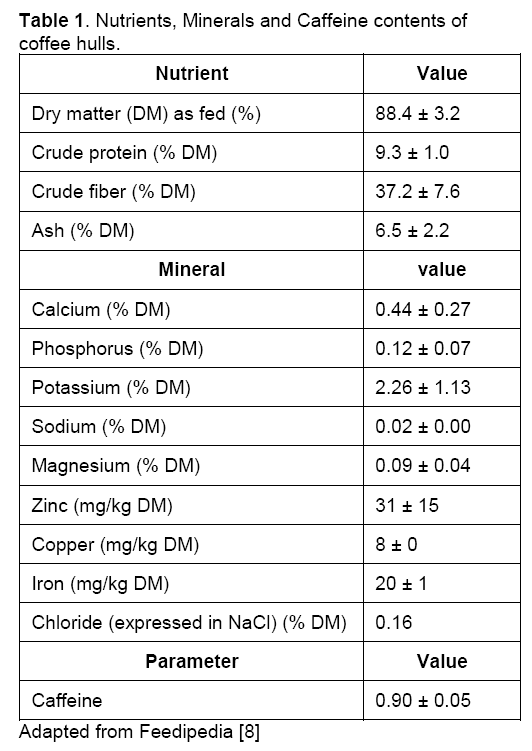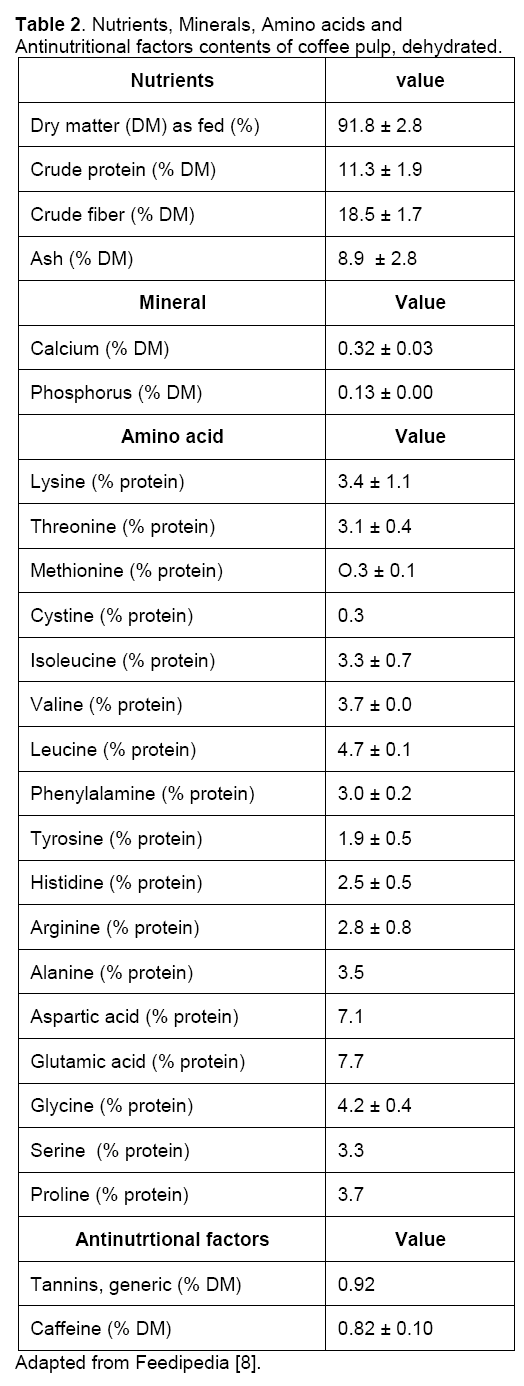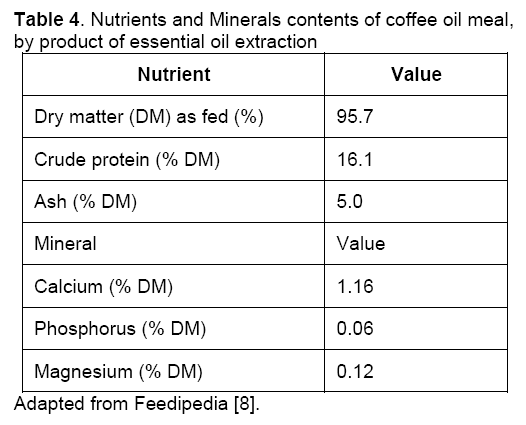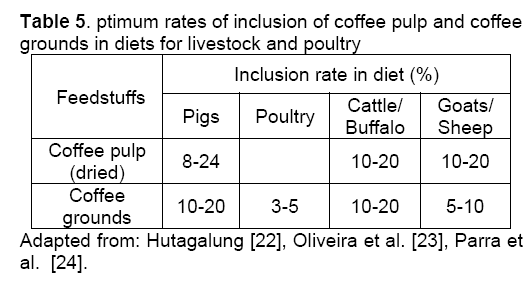Potential Food Waste and By-products of Coffee in Animal Feed
BOUAFOU Kouamé Guy Marcel, KONAN Brou André, ZANNOU-TCHOKO Viviane, KATI-COULIBALLY Séraphin
1Division of Life Sciences and Earth,Department of Science and Technology,Ecole Normale Supérieure d'Abidjan (Côte d’Ivoire),25 BP 663 Abidjan 25
2Laboratory of Nutrition and Pharmacology,UFR-Biosciences,Cocody University (Côte d’Ivoire),22 B.P. 582 Abidjan 22
- Corresponding Author:
- BOUAFOU Kouamé Guy Marcel
Division of Life Sciences and Earth
Department of Science and Technology
Ecole Normale Supérieure d'Abidjan (Côte d’Ivoire),25 BP 663 Abidjan 25
Tel: +22566529238/+22540309965
E-mail: publicationbouafou@yahoo.fr
Abstract
This review of the literature reveals the potential nutritional waste and by-products of coffee farming. Indeed, waste and by-products of coffee generally contains 10% of crude protein, 37% of crude fiber and minerals such as Ca and P. Used in animal feed, waste and by-products of coffee have ruminants, pigs, fish and chicken good animal performance at respective rates of use of 10-30%, 10-24%, 13-30% and 2.5-5%, without affecting their physiology and health. But caffeine and tannins (2-4.5%) associated with the alkaloids contained in these foods limit their ingestion in large quantities as affecting the health of animals and reducing the palatability of the plans. However, drying, silage, physical (percolation), chemical (alcohol extraction) or microbiological (fermentation with Aspergillus niger) methods contribute to reduce levels of caffeine and tannins of waste and by-products of coffee.
Keywords
Coffee-Waste and by-products- Nutritional value- Breeding- Research synthesis.
1. Introduction
World population is clearly growing. For food,we need agricultural and animal production. Yet agricultural production,in short supply should also be used for animals. To reduce competition for food,it is wise to seek other food sources for breeding alternatives: waste and agricultural by-products. Waste and by-products of coffee amount in the millions of tons in the world in terms of productions from Brazil and Côte d’Ivoire. This updated review of the literature aims to show the potential of food waste and by-products of coffee in the feed.
2. Preparation of silage and processing of coffee waste and by-products
Coffee husk and coffee pulp are coffee processing by-products. Coffee husk is obtained when harvested coffee is processed by the dry method,and coffee pulp is produced by the wet method. In Brazil,coffee is usually processed by the dry method; therefore an expressive amount of husk is obtained every year [1].
The pulp from dry processing is fibrous and rather poor roughage: that from wet processing has a much higher feed value [2] but is high in moisture and does not store well. Ensiling with other feed resources appears to be the best method of preservation and improvement of the nutritive value of pulp.
Otherwise,two experiments were conducted with yearling rams to evaluate the nutritive value of coffee pulp ensiled on its own and ensiled in combination with either sugarcane stem,sugarcane top or elephant grass (Pennisetum purpureum) [3;4]. Good quality silage was produced from coffee pulp alone and in combination with the forages. Percentage composition of lignin,lignified protein and caffeine were highest in pure pulp silage and decreased,as a result of dilution by forages,in the others [2;3]. Silage process improved overall feed utilization comparing to fresh coffee pulp. However,better knowledge on modification occurring during silage process could allow finding the way to significantly improve nutritive value of coffee pulp by-products [5]. According to Bressani [6],fresh coffee pulp can be ensiled with 4-6% sugar cane molasses. Although it can be directly ensiled,better quality is obtained if moisture content is around 75%. A well-packed trench silo holds an average of 325 kg of coffee pulp per cubic meter. Other treatments include mixing with urea (10%),sodium metabisulphite (0.3-0.5%),calcium hydroxide (2%),and mixtures of inorganic acids (10% HCl + H2SO4). A different and attractive ensiling process is to mix grasses,sorghum or corn,with coffee pulp in layers of about 30 cm with or without sugar cane molasses (4-6%). The silage,whether of coffee pulp alone,or mixed with grasses,is ready to be used in about 3 weeks and if well packed,it can be preserved for up to 18 months. The silage from coffee pulp alone or mixed with other forages can be used as such,or it can be dehydrated (but this operation is not necessary) [6].
Moreau et al. [5] observed that silage process seemed to decrease parts of the anti nutritional effect observed with fresh coffee pulp. Coffee pulp ensilage is also a valid alternative to handling and storing the huge amounts of coffee pulp produced in the factories around the world which process coffee fruits. The inclusion of coffee pulp silage in the diets of some farm animals could contribute to lowering the meat and milk production costs,especially in developing countries [7].
3. Chemical composition
Chemical compositions of coffee hulls,coffee pulp (dehydrated),coffee oil meal,and by product of essential oil extraction are showed in Tables 1,2,3 and 4.




4. Nutritional value
The nutritional value of waste and by-products of coffee has been studied by several researchers.In 1974,Catie has already said that coffee pulp has a promising role in livestock feeding if it can be efficiently and economically dehydrated. Three years later,Cabezas et al. [9],cited by Cabezas et al. [10],incorporated 20%,40% or 60% of sun-dried coffee pulp in rations as (15% and protein) partial replacement of cottonseed meal and cottonseed hulls,enriched with a mixture of sugar cane molasses and minerals,and observed the intake and digestibility in calves. Protein was kept at 15%. Although the digestibility of the organic matter increased from 51.2% (0% coffee pulp) to 54% (60% coffee pulp) and the gross energy had not changed,the digestibility of protein decreased from 47% (0% coffee pulp) to 36.2% (60% coffee pulp). The authors suggested that the observed increase was a consequence of the reduction of the daily intake,since it dropped from 3.5 kg 100 kg-1 live weight to 2.1,as the coffee pulp increased from 0 to 60% in the diet. Ingestion of coffee pulp was estimated to be 1.3 kg 100 kg-1 live weight at the 60% coffee pulp level.
4.1 In ruminants: sheep and cattle
The first studies with ruminants showed that cattle accepts coffee pulp as food only when supplemented with highly palatable feeds,forage,and protein concentrate [10]. In the same year,some studies have been carried out on the use of coffee pulp as food for animal husbandry [10;11]. These studies were conducted in countries where coffee is processed mainly by the wet,method what explains the lack of information on coffee husk.
Ranging from 15% to 20% Coffee hulls have been reported to replace several feeds in sheep diets. It is suggested to supply it with a high energy fodder [11]. Recommended inclusion rates 5% dietary level when replacing respectively concentrate and berseem hay,or ground maize [13;14]. Coffee pulp is a waste material from the coffee industry. Rathinavelu and Graziosi [7] showed that it can replace up to 20% of commercial concentrates in dairy cattle feeding,with no adverse effects and a 30% cost savings.
4.2. In pigs
Dried coffee pulp is accepted by pigs from 8 to 16% in the ration [15-16]. At certain growth stages,lower weight gain was attributed to phenolics in the coffee pulp,since a study with decaffeinated coffee pulp showed that its addition to the ration did not improve the performance of pigs in comparison to normal coffee pulp [17]. Cunningham [18] fed pigs with caffeine at the levels of 1.5 g kg-1 and observed that nitrogen retention increased 7.9%,although a lower ration intake was detected. Therefore,considering the levels of coffee pulp used by Jarquín et al. [15-16],it is probable that caffeine was not responsible for the diminished weight gain and feed conversion.
In 1985,a total of 40 Large White growing pigs were fed on diets containing either 0.5,10,15 or 20% dried coffee pulp [19]. After a 12-week feeding trial,during which both feed and water were available ad libitum,half of the pigs (males) on each treatment were slaughtered. Average daily feed intake and weight gain,feed conversion efficiency and the various carcass traits measured were not significantly influenced by the inclusion of up to 20% dried coffee pulp. In another study,Okai and Dabo [20] fed four groups of five pigs with rations containing 0,10,20,or 30% of dried coffee pulp over a period of 10 weeks. They conclude that the inclusion of these rations had no significant influence on the feed intake,growth rate and feed conversion efficiency.
Overall results from feeding studies with pigs indicated that corn can be substituted by dehydrated coffee pulp for up to 16% of the total ration,with no detrimental effect on weight gain or feed conversion. This means that at the end of the finishing period,each reared pig has left nearly 50 kg of corn available for human consumption or alternative uses (Rathinavelu and Graziosi,2005). The feeding trials included the determination of daily body weight gain,daily dry matter intake,and feed conversion efficiency. Pigs fed with rations containing up to 15% of coffee pulp ensiled with 5% molasses had equal or better total weight gain than those fed commercial concentrates [7]. In addition,Oliveira et al. [21] argue that feeding pigs with coffee by-products may be of interest as indicated in Table 5 summarizes the recommended levels of inclusion.

4.3. In fish and poultry
Besides pigs,coffee pulp feeding trials were carried out with fish and chicks.
Coffee pulp also did not affect the growth of the fish Tilapia aurea [25]. Compared to chicken manure,there was higher weight gain with a diet consisted of pellets containing 30% of coffee pulp plus wheat bran,ground corn,molasses,cottonseed oil meal,urea,and bone meal. Chicken manure was similar to a control diet that did not receive any additional supplementation.
The use of coffee pulp has been studied in tilapia (Oreochromis aureus). Its use is limited by the levels of tannins,caffeine and fiber. A dietary inclusion level of 13% coffee pulp in the diet did not affect growth and feed efficiency when compared with the control diet. Caffeine dietary levels between 2.4 g/kg to 4.6 g/kg tended to reduce fish growth,feed intake and nutrient digestibility in tilapia fingerlings. Bacterial inoculation was found to be a promising way to increase the nutritive value of coffee pulp for tilapias [26]. Dietary protein and energy utilization of diets containing fresh and ensiled coffee pulp were studied on 3.2 ± 0.2 g Nile tilapia for 28 days [5]. Fresh or ensiled coffee pulp should not be considered as suitable feedstuffs for Nile tilapia. Results showed that fresh or ensiled coffee pulp was not a suitable feedstuff for Nile tilapia [5].
In broilers,dried coffee pulp has a low nutritive value and the maximum recommended level is 2.5% [27].
5. Risks associated with the use of waste and by-products of coffee
Coffee pulp (dried or not),coffee hulls (sticky or dried) and coffee grounds (a by-product of instant coffee manufacture) have an overall deleterious effect on pigs [15;22;28;29;30]. The cherry and the leaves of coffee contain caffeine,an alkaloid that is a psychoactive stimulant drug,as well as tannins,polyphenols and high amounts of potassium [31]. The presence of these factors contributes to the antinutritional and antiphysiological activity of coffee by-products as observed in both monogastrics and ruminants,such as low palatability,feed intake,protein digestibility and nitrogen retention [1;32;34;34]. So limitations for the use coffee pulp in animal feeding are connected to its high contents on tannins and caffeine [35;36]. Pandey and Soccol [38] followed by Ramirez-Martinez [39] reported (dry matter basis) respectively 4.5% and 2 to 4% tannins in coffee pulp. Tannins are known to confer astringency to foodstuffs and complex proteins,affecting food digestibility and decreasing nitrogen utilization animals. Similarly,they are reported to damage protein digestibility as well as assimilation either through interaction of tannin with dietary protein or through inhibition of digestive proteases [39;40].
Although caffeine presents a somewhat bitter taste,thereby affecting palatability,the main limitations of this alkaloid for animal feeding are related to its physiological effects on the central nervous system [35]. Mazzafera [1] also believes that the presence of tannins and caffeine diminish acceptability and palatability of husk by animals [1]. According to Aregheore [41] supported by Rathinavelu and Graziosi [10] [7],the use of coffee pulp in animal feeding makes the food less palatable and interferes with nutrient availability and absorption in the gastrointestinal tract. Nitrogen availability is certainly affected by formation of protein complex by tannins.
On the one hand,caffeine causes embryonic mortality in hens at levels of 0.05 and 0.1%. Those fed with the highest level produced a 38.2% mortality rate [42]. On the other hand,dietary,coffee pulp severely decreased weight gain and caused 100% mortality in chicks [43],which received diets containing 50% coffee pulp for 6 weeks.
It should be noted that the ingestion of coffee pulp has no effect on blood biochemical parameters (glucose,protein,P,Ca,cholesterol) in pigs. However they had less back fat and higher liver weights [20].
6. Reduce levels of caffeine and tannin waste and by-products of coffee
It is possible to reduce the levels of caffeine and tannin waste and by-products of coffee to increase their use in animal feed. Physical (percolation),chemical (alcohol extraction) or microbiological (fermentation) methods may help reducing caffeine content and enhance animal performances [32;34;33]. Drying followed by several months of storage may reduce the amount of antinutritional factors [43]. Coffee pulp fermented with Aspergillus niger was used successfully at 10% dietary level [33].
Caffeine can be significantly reduced by microorganisms [1]. Several studies have shown that coffee fruits are a rich source of microorganisms. Boccas et al. [44] isolated 248 fungal cultures from coffee plants and soil collected from plantation areas. Roussos et al. [45] isolated 272 strains of filamentous fungi from soil,fruits and leaves using a culture media containing coffee extract,coffee extract plus sucrose,and coffee pulp extract. The fungi strains with the highest ability to degrade caffeine were identified as Aspergillus and Penicillium. Yamaoka-Yano and Mazzafera [46] isolated more than 20 bacteria strains from soil collected under coffee plants,observing predominance of Pseudomonas sp.,which was also the most efficient caffeine degrader. Yamaoka-Yano and Mazzafera [47] used the same P. putida strain,used by Yamaoka-Yano and Mazzafera [46],to study coffee husk decaffeination. Different proportions of inoculum and husk were incubated during 30 days,resulting in a reduction of up to 80% of caffeine. At shorter incubation periods (9 days) a 40% reduction was observed.
7. Conclusions
Following this review,it appears that much research has focused on the use of waste and by-products of coffee to feed the animals.
First,researchers have shown that silage improves the nutritional quality of waste and by-products of coffee. Silage can be made with the feed,with 4-6% of the molasses from sugar cane or with a mixture of chemicals. Then the chemical compositions of waste and by-products of coffee were determined. These foods contain mainly crude protein (9-11%),crude fiber (35-40%) of major minerals (Ca,P) and anti-nutritional factors such as caffeine and tannins. Finally the nutritional,waste and by-products of coffee have been incorporated in the diets of some animals. In the diets of ruminants is to say,cattle and sheep,waste and by-products of coffee have successfully used 10 to 30%. Incorporation rates vary considerably from one author to another. In pigs,waste and by-products of coffee were also used in the diet up to 10-24% risk-free. For fish and chicken,limited information suggests the introduction of waste and by-products in rations of coffee with respective rates of 13-30% and 2.5-5%. Limiting the use of waste and by-products of coffee by the animals is due to their caffeine content,tannin and alkaloids that affect their health and negatively affect the palatability of the diets. But drying,silage,physical (percolation),chemical (alcohol extraction) or microbiological (fermentation with Aspergillus niger) methods contribute to lower levels of caffeine and tannins of waste and by-products of coffee.
Acknowledgements
This research project has been supported by Islamic Azad University,Khorasgan (Isfahan) branch,Isfahan,Iran. This support is highly appreciated.
References
- Mazzafera P. (2002) Degradation of caffeine by microorganisms and potential use of decaffeinated coffee husk and pulp in animal feeding. Sci. Agri.,59: 815-821.
- Fao (1981) Tropical feeds. Food and Agriculture Organization of the United Nation. Rome,Italy.
- Catie (1974) Primera reunion international sobre la utilisacion de los subproductors de cafe en alimentacion animal y atras aplicaciones agricoles e industrials. Informe final. Centro Agronomico Tropical de Investigacion y Ensenanza,Turrialba,Costa Rica.
- Cabezas M.T.,Vargas E.,Murillo B.,Bressani R. (1979) Utilization of coffee pulp in ruminant feeding. Coffee pulp composition,technology and utilization. International Development Research Centre,Ottawa,Canada.
- Moreau Y.,Arredondo J.L.,Perraud-Gaime I.,Roussos S. (2003) Dietary utilisation of protein and energy from fresh and ensiled coffee pulp by the Nile tilapia,Oreochromis niloticus. Braz. Arch. Biol. Technol.,46,223-231.
- Bressani R. (1991) Coffee,Coffee pulp. In: Tropical feeds version 3.0a,Bo Göhl ed.,FAO,Rome.
- Rathinavelu R.,Graziosi G. (2005) Potential alternative use of coffee wastes and by-products. International Coffee Organization,1967/ 05,1-2.
- Feedipedia. 2011. Coffee hulls,fruit pulp and by-products. Tables Régions Chaudes. A project by Inra,Cirad and Afz with the support of Fao.
- Cabezas M.T.,Vargas E.,Murillo B.,Bressani R. (1977) Utilization of coffee fruit without seeds (coffee pulp) in ruminant feeding. First international symposium on feed composition,animal nutrient requirements and computerization of diets. Utah State University,Logan,USA.
- Cabezas M.T.,Flores A.,Egana J.I. (1987) Use of coffee pulp in ruminant feeding. In: Brahan,J.E.; Bressani,R. (Ed.) Coffee pulp: composition,technology,and utilization. Guatemala City: Institute of Nutrition of Central America and Panama,25-38.
- Brahan,J.E.,Jarquín,R.,González J.M.,Bressani R. (1973) Pulpa y pergamino de café. III. Utilización de la pulpa de café en la alimentación de rumiantes. Turrialba,23: 41-47.
- Leitao R.A.,Paiva P.C.,Rezende C.A.P. (2005) Nutritive value of coffee (Coffea arabica L.) hulls treated with sodium hydroxide and/or urea supplemented with alfalfa (Medicago sativa L.) hay. Pesquisa Agropecuaria Tropical,35 (1): 31-36.
- El-Sayed H.M.,El-Nor S.A.H.A.,Kholif A.M.,Tawila M.A. (1999) In vivo evaluation of coffee bean shell as a component in ruminant rations. Egypt. J. Nutr. Feeds,2 (1): 1-7.
- Souza,A.L.,Garcia R.,Bernardino F.S.,Rocha F.C.,Valadares Filho S.C. (2004) Coffee hulls in the diet of sheep: intake and apparent digestibility. Rev. Bras. Zootech.,33 (6 Supplement 2): 2170-2176.
- Jarquín R.,Rosales F.A.,González J.M.,Braham J.E. Bressani R. (1974) Pulpa y pergamino de café. IX. Uso de la pulpa de café en la alimentación de cerdos en la fase de crecimiento y acabado. Turrialba,24 : 41-46.
- Jarquín,R.; Gomes-Brenes,L.; Bressani,R. (1977) Efectos de los nívelesn proteínicos y de la pulpa de café en raciones para cerdos criolles.Turrialba,27 : 179-185.
- Jarquín,R. Coffee pulp in swine feeding. In: Brahan,J.E.; Bressani,R. (1987) Coffee pulp: composition,technology,and utilization. Guatemala City: Institute of Nutrition of Central America and Panama,39-49.
- Cunningham H.M. (1968) Effects of caffeine on nitrogen retention,carcass composition,fat mobilization and the oxidation of C14-labeled body fat in pigs. Journal of Animal Science,27: 242-430.
- Okai,D.B.,Bonsi M.L.K.,Easter R.A. (1985) Dried coffee pulp as an ingredient in the diets of growing pigs. Trop. Agri.,62 (1): 62-64.
- Okai D.B.,Dabo P. (1991) Further studies on the effects of diets containing dried coffee pulp: growth performance,blood and carcass characteristics of pigs. Beitrage zur tropischen Landwirtschaft und Veterinarmedizin,29 (2): 235-241.
- Oliveira V.,Fialho E.T.,Lima J.A.,Oliveira A.I.G.,Freitas R.T.F. (2001) Substitution of corn by coffee hulls in isoenergetic diets for growing and finishing pigs: digestibility and performance. Ciencia Agrotecnologia,25 (2): 424-436.
- Hutagalung R.I. (1981) The use of tree crops and their by-products for intensive animal production. In: Intensive animal production in developing countries (A J Smith and R G Gunn ed.). Brit. Soc. Anim. Prod. Occ. Publ.,4: 151-188.
- Oliveira S.L.,Fialho E.T.,Murgas L.D.S.,Freitas R.T.F.,Oliveira A.I.G. (2002) Use of sticky coffee hulls in rations for finishing swine. Ciencia Agrotecnologia,26 (6): 1330-1337.
- Parra,A. R. P.; Moreira,I.; Furlan,A. C.; Paiano,D.; Scherer,C.; Carvalho,P. L. de O.,2008. Coffee hulls utilization in growing and finishing pigs feeding. Revista Brasileira de Zootecnia,37 (3): 433-442.
- Garcia R.,Bayne D.R. (1974) Cultivo de Tilapia aurea (Steindachner) en corrales de 100 m2,alimentada artificialmente con gallinaza y un alimento preparado con 30 % de pulpa de café. San Salvador: Ministerio de Agricultura y Ganadería,Dirección General de Recursos Naturales renovables,Servicio Piscícola.
- Rojas J.B.U. (2002) Use of coffee pulp as feed ingredient for tilapia culture. Fish Culture and Fisheries Group,Wageningen Institute of Animal Sciences,Thesis,133 pp.
- Donkoh A.,Atuahene C.C.,Kese A.G.,Mensah-Asante B. (1988) The nutritional value of dried coffee pulp (DCP) in broiler chickens' diets. Anim. Feed Sci. Technol.,22 (1-2): 139-146.
- Buitrago J.,Calle H.,Gallo J.T.,Corzo M.A. (1970) Coffee molasses in diets for growing and finishing pigs. Revista del Instituto Colombiano Agropecuario,5 (4): 407-410.
- Balogun T.F.,Koch B.A. (1973) Coffee grounds in swine rations. Swine Day,Manhattan,KS,Kansas State University.
- Balogun T.F.,Koch B.A. (1975) Coffee grounds replacing sorghum grains in pig rations. Tropical Agriculture,52 (3): 243-249 [32]
- Bressani R.,1982. Coffea arabica. in Göhl B.,1982. Les aliments du bétail sous les tropiques. Division de Production et Santé Animale,FAO,Rome,Italy.
- Molina M.R.,De la Fuente G.,Batten M.A.,Bressani R. (1974) Decaffeination: a process to detoxify coffee pulp. J. Agric. Food Chem.,22 (6): 1055–1059.
- Peñaloza W.,Molina M.R.,Brenes R.G.,Bressani R. (1985) Solid-state fermentation: an alternative to improve the nutritive value of coffee pulp. Appl Environ Microbiol.,49(2): 388–393.
- Brand D.,Pandey A.,Roussos S.,Soccol C.R. (2000) Biological detoxification of coffee husk by filamentous fungi using a solid state fermentation system. Enzyme and Microbial Technology,27(1-2): 127-133.
- Bressani,R.,1982. Coffea arabica. in Göhl B.,1982. Les aliments du bétail sous les tropiques. Division de Production et Santé Animale,FAO,Rome,Italy.
- Clifford M.N.,Ramirez-Menezes J.R. (1991) Tannins in wet-processed coffee beans and coffee pulp. Food Chem.,40: 35-42.
- Pandey A.,Soccol C.R. (1998) Bioconversion of biomass: A case study of lignocellulosics bioconversions in solid state fermentation. Braz. Arch. Biol. Technol.,4: 379-390,
- Ramirez-Martinez J.R. (1999) Pulpa de café ensilada. Producción,caracterización y utilización en alimentación animal. Universidad Nacional Experimental del Táchira (UNET),San Cristóbal,Estado Táchira,Venezuela.
- Reed J. D. (1995) Nutritional toxicology of tannins and related polyphenols in forage legumes. J. Anim. Sci.,73: 1516-1528.
- Bravo,L. (1998),Polyphenols: chemistry,dietary sources,metabolism,and nutritional significance. Nutr. Rev.,56,317-33.
- Aregheore E.M. (1998) A review of implications of antiquality and toxic components in unconventional feedstuffs advocated for use in intensive animal production in Nigeria. Veterinary and Human Toxicology,40: 35-39.
- Ax R.L.,Lodge J.R.,Bray D.J. (1974) Increased embryonic loss in chickens from 0.05% dietary caffeine. Poultry Science,53 : 830-831.
- Bressani R.,Estrada E.,Elías L.G.,Jarquín R.,Urrutia de Valle L. (1973) Pulp y pergamino de café. IV. Efecto de la pulpa de café deshidratada en la dieta de ratas y pollos. Turrialba,23: 403-409.
- Boccas F.,Roussos S.,Gutierrez M.,Serrano L.,Viniegra G.G. (1994) production of pectinase from coffee pulp in solid-state fermentation system - selection of wild fungal isolate of high potency by a simple 3-step screening technique. J. Food Sci. Technol.,31: 22-26.
- Roussos S.,Aquiáhuatl M.A.,Trejo-Hernández M.R.,Perraud I.G.,Favela,E.,Ramakrishma M.,Raimbault M.,Viniegragonzález G. (1995) Biotechnological management of coffee pulp-isolation,screening,characterization,selection of caffeine-degrading fungi and natural microflora present in coffee pulp and husk. Appl. Microbiol. Biotech.,42: 756-762.
- Yamaoka-Yano D.M.,Mazzafera,P. (1998) Degradation of caffeine by Pseudomonas putida isolated from soil. Allelopathy Journal,5: 23-34.
- Yamaoka-Yano D.M.; Mazzafera P. (1996) Descafeinação da palha de café por bactérias. In: Congresso brasileiro de pesquisas cafeeiras,22,Águas de Lindóia,1996. Resumos. Rio de Janeiro:nMinistério da Agricultura e Reforma Agrária,36-39.

Open Access Journals
- Aquaculture & Veterinary Science
- Chemistry & Chemical Sciences
- Clinical Sciences
- Engineering
- General Science
- Genetics & Molecular Biology
- Health Care & Nursing
- Immunology & Microbiology
- Materials Science
- Mathematics & Physics
- Medical Sciences
- Neurology & Psychiatry
- Oncology & Cancer Science
- Pharmaceutical Sciences
